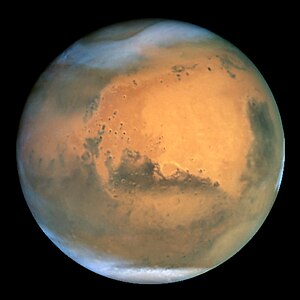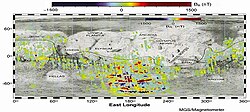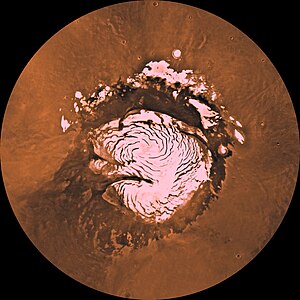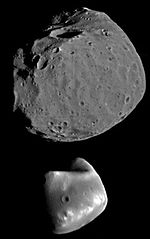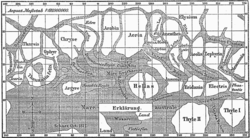Mars (planet)
Mars is the fourth planet from the Sun in our solar system and is named after Mars, the Roman god of war. Mars is also known as the "Red Planet" due to its reddish appearance when seen from Earth.
Although its surface is, by terrestrial standards, a harsh, cold, desolate desert, Mars is arguably the most Earth-like object in our Solar System. Its rotational period (i.e. "day") and pattern of seasonal cycles are similar to those of the Earth. It has the highest mountain in the solar system, Olympus Mons, the largest canyon in the solar system, Valles Marineris, and polar ice caps. It had liquid water on its surface at various points in its history (and may even currently have it in certain areas). Thus Mars may have harbored life in the past and it is possible that it exists there still.
Mars has two moons, Phobos and Deimos, which are small and oddly-shaped. Mars can be seen from Earth by the naked eye. Its apparent magnitude reaches -2.9, a brightness surpassed only by Venus, the Moon, and the Sun. For much of the year, Jupiter may appear brighter to the naked eye than Mars.
Mars is currently host to three active orbiting spacecraft, more than any planet other than Earth. It is also home to the two Mars Exploration Rovers, Spirit and Opportunity.
Physical characteristics
The red/orange appearance of Mars' surface is caused by iron(III) oxide (rust).[1] Mars has half the radius of the Earth and only one-tenth the mass, being less dense, but its surface area is only slightly less than the total area of Earth's dry land.[2] While Mars is larger and more massive than Mercury, Mercury has slightly stronger gravity at the surface, due to its much higher density.
Geology
The surface of Mars is thought to be primarily composed of basalt, based upon the Martian meteorite collection and orbital observations. There is some evidence that a portion of the Martian surface might be more silica-rich than typical basalt, perhaps similar to andesitic stones on Earth, though these observations may also be explained by silica glass. Much of the surface is deeply covered by iron(III) oxide dust as fine as talcum powder.[3]

There is conclusive evidence that liquid water existed at one time on the surface of Mars. Key discoveries leading to this conclusion include the detection of various minerals such as hematite and goethite which usually only form in the presence of water.[4]
Although Mars has no intrinsic magnetic field, observations have revealed that parts of the planet's crust have been magnetized. This magnetization has been compared to alternating bands found on the ocean floors of Earth. One theory, published in 1999 and reexamined in October 2005 with the help of the Mars Global Surveyor, is that these bands are evidence of the past operation of plate tectonics on Mars.[5]
Current models of the planet's interior infer a core region approximately 1,480 km in radius, consisting primarily of iron with about 15-17% sulfur. This iron sulfide core is partially fluid, with twice the concentration of light elements that exists at the Earth's core. The core is surrounded by a silicate mantle that formed many of the tectonic and volcanic features on the planet, but now appears to be inactive. The average thickness of the planet's crust is about 50 km, and it is no thicker than 125 km.[6]
The geological history of Mars is split into three broad epochs:
- Noachian epoch (named after Noachis Terra): Formation of Mars to between 3800 and 3500 million years ago. Noachian age surfaces are scarred by many large impact craters. The Tharsis bulge is thought to have formed during this period, with extensive flooding by liquid water late in the epoch.
- Hesperian epoch (named after Hesperia Planum): 3500 million years ago to 1800 million years ago. The Hesperian epoch is marked by the formation of extensive lava plains.
- Amazonian epoch (named after Amazonis Planitia): 1800 million years ago to present. Amazonian regions have few meteorite impact craters but are otherwise quite varied. Olympus Mons formed during this period along with lava flows elsewhere on Mars.
An alternative series of classifications, based on data from OMEGA Visible and Infrared Mineralogical Mapping Spectrometer on board the Mars Express orbiter has also been put forward.
Geography of Mars
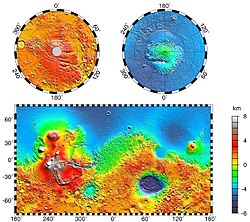
Although better remembered for mapping the Moon starting in 1830, Johann Heinrich Mädler and Wilhelm Beer were the first "areographers". They started off by establishing once and for all that most of Mars' surface features were permanent, and pinned down Mars' rotation period. In 1840, Mädler combined ten years of observations and drew the first ever map of Mars. Rather than giving names to the various markings they mapped, Beer and Mädler simply designated them with letters; Meridian Bay (Sinus Meridiani) was thus feature "a".[7]
Today, features on Mars are named from a number of sources. Large albedo features retain many of the older names, but are often updated to reflect new knowledge of the nature of the features. For example, Nix Olympica (the snows of Olympus) has become Olympus Mons (Mount Olympus).[8]
Mars' equator is defined by its rotation, but the location of its Prime Meridian was specified, as was Earth's, by choice of an arbitrary point. Mädler and Beer selected a line in 1830 for their first maps of Mars. After the spacecraft Mariner 9 provided extensive imagery of Mars in 1972, a small crater (later called Airy-0), located in the Sinus Meridiani ("Middle Bay" or "Meridian Bay"), was chosen for the definition of 0.0° longitude to coincide with the originally selected line.[9]
Since Mars has no oceans and hence no 'sea level', a zero-elevation surface or mean gravity surface must be selected. The zero altitude is defined by the height at which there is 610.5 Pa (6.105 mbar) of atmospheric pressure (approximately 0.6% of Earth's). This pressure corresponds to the triple point of water.[10]
The dichotomy of Martian topography is striking: northern plains flattened by lava flows contrast with the southern highlands, pitted and cratered by ancient impacts. The surface of Mars as seen from Earth is thus divided into two kinds of areas, with differing albedo. The paler plains covered with dust and sand rich in reddish iron oxides were once thought of as Martian 'continents' and given names like Arabia Terra (land of Arabia) or Amazonis Planitia (Amazonian plain). The dark features were thought to be seas, hence their names Mare Erythraeum, Mare Sirenum and Aurorae Sinus. The largest dark feature seen from Earth is Syrtis Major.[11]
The shield volcano, Olympus Mons (Mount Olympus), at 26 km is the highest known mountain in the solar system. It is an extinct volcano in the vast upland region Tharsis, which contains several other large volcanoes. It is over three times the height of Mt. Everest which in comparison only stands at 8848m.
Mars is also scarred by a number of impact craters. The largest of these is the Hellas impact basin, covered with light red sand.[12]There are many less craters in comparison to The Moon, despite Mars being closer to the asteroid belt, this is due to the atmosphere which provides protection against small meteors. Some craters have a morphology that suggests that the ground was wet when the meteor impacted.
The large canyon, Valles Marineris (Latin for Mariner Valleys, also known as Agathadaemon in the old canal maps), has a length of 4000 km and a depth of up to 7 km. The length of Valles Marineris is equivalent to the length of the Europe and is extends for fifth of the circumference of Mars. For comparison the Grand Canyon on Earth is only 446 km long and nearly 2km deep. Valles Marineris was formed due to swelling of the Tharis area which caused the crust in the area of Valles Marineris ot collapse. Another large canyon is Ma'adim Vallis (Ma'adim is Hebrew for Mars) it is 700 km long and, and again much bigger that the Grand Canyon with a width of 20 km ad a depth of 2 km in some places. It is possible that Ma'adim Vallis was flooded with liquid water in the past.
Atmosphere
The atmosphere of Mars is relatively thin; the atmospheric pressure on the surface is only 0.003–0.847 kPa, compared to Earth's 101.3 kPa, The equivalent pressure of Mars' atmosphere can be found at a height of 35km above the Earth's surface. The scale height of the atmosphere is about 11 km, higher than Earth's 6 km. The atmosphere on Mars consists of 95% carbon dioxide, 3% nitrogen, 1.6% argon, and contains traces of oxygen and water.[2] The atmosphere is quite dusty, giving the Martian sky a tawny color when seen from the surface, with dust particles about 1.5 µm across.[13]
Methane exists in the Martian atmosphere with a concentration of about 10 ppb by volume.[14] Methane is an unstable gas that is broken down by ultraviolet radiation, typically lasting in the atmosphere for about 340 years,[15] and its possible presence on Mars could indicate that there is (or has been within the last few hundred years) a source of the gas on the planet. Volcanic activity, comet impacts, and the existence of life in the form of microorganisms such as methanogens are among possible sources. It was recently shown that methane could also be produced by a non-biological process involving water, carbon dioxide, and the mineral olivine, which is known to be common on Mars.[16]
In the winter months when the poles are in continuous darkness, the surface gets so cold that as much as 25–30% of the entire atmosphere condenses out into thick slabs of CO2 ice (dry ice).[17]
When the poles are again exposed to sunlight, the CO2 ice sublimes, creating enormous winds that sweep off the poles as fast as 400 km/h (250 mph). These seasonal actions transport large amounts of dust and water vapor, giving rise to Earth-like frost and large cirrus clouds. Clouds of water-ice were photographed by the Opportunity rover in 2004.[18]
Magnetosphere
Evidence indicates that in Mars' distance past, it may have had a strong enough magnetosphere to deflect the solar wind coming from the Sun. However, about 4 billion years ago Mars' planetary dynamo ceased, leaving only remnants of the planetary magnetic field to be frozen into magnetically susceptible minerals. Over time, most of this material was reprocessed through various geological events leaving only sections of the ancient southern highlands with remnant magnetic fields. Because of this, the solar wind interacts directly with the Martian ionosphere and thus the Martian atmosphere has been slowly stripped off into space, although the exact amount lost remains uncertain. Both Mars Global Surveyor and Mars Express have detected ionised atmospheric particles trailing off into space behind Mars.[19][20]
Climate
Mars has seasons. Of all the planets, Mars' seasons are the most Earth-like due to the similar tilts of the two planets' rotational axes. However, the lengths of the Martian seasons are about twice those of Earth's, as Mars' greater distance from the sun leads to the Martian year being approximately two Earth years in length. Martian temperatures vary from lows of –140 °C (−220 °F) in polar winters to highs of 21 °C (70 °F) in summers. It is suggested, however, that temperatures could reach as low as -155 °C (-250°F) and as high as 29 °C (85°F). The wide range in temperatures is due to the thin atmosphere which cannot store much solar heat.[21] Recent evidence has suggested that Mars is subject to short term climate changes, such as warming of the south pole.[22]
Mars also has the largest dust storms in the Solar System. These can vary from a storm over a small area, to gigantic storms that cover the entire planet. They tend to occur when Mars is closest to the Sun, which increases the global temperature.[23]
Mars possesses polar caps at both poles, which mainly consist of frozen carbon dioxide (dry ice) as well as a small amount of water ice. The northern polar cap has a diameter of approximately 1,000 kilometers during the northern Mars summer, and its thickness is estimated at 5 km. The southern polar cap has a diameter of 350 km, and a thickness of 3.5km. Both polar caps show spiral cuts, which remain unexplained. Both polar caps shrink and regrow following the temperature fluctuation of the Martian seasons.
Orbit and rotation
Mars has a relatively pronounced orbital eccentricity of about 9%; of the other planets in the solar system, only Mercury shows greater eccentricity. Mars' average distance from the Sun is roughly 230 million km (1.5 AU) and its orbital period is 687 (Earth) days. The solar day (or sol) on Mars is only slightly longer than an Earth day: 24 hours, 39 minutes, and 35.244 seconds.
Mars' axial tilt is 25.19 degrees, which is similar to the axial tilt of the Earth. As a result, Mars has seasons like the Earth, though Mars' are about twice as long given its longer year.
The image to the right shows a comparison between Mars and Ceres, a dwarf planet in the Asteroid Belt as seen from the ecliptic pole (top) and from the ascending node (below). The segments of orbits below the ecliptic are plotted in darker colours. The perihelia (q) and aphelia (Q) are labelled with the date of the nearest passage. Mars passed its perihelion in June 2006 and is now heading for its aphelion in June 2007. Interestingly, the perihelia of Ceres and Mars are on the opposite side of the Sun, minimising the perturbation of Ceres' orbit by Mars.
Moons
Mars has two tiny natural moons, Phobos and Deimos, which orbit very close to the planet and are thought to be captured asteroids.[24]
Both satellites were discovered in 1877 by Asaph Hall, and are named after the characters Phobos (panic/fear) and Deimos (terror/dread) who, in Greek mythology, accompanied their father Ares, god of war, into battle. Ares was known as Mars to the Romans.[25]
From the surface of Mars, the motions of Phobos and Deimos appear very different from that of our own moon. Phobos rises in the west, sets in the east, and rises again in just 11 hours, while Deimos, being only just outside synchronous orbit, rises as expected in the east but very slowly. Despite its 30 hour orbit, it takes 2.7 days to set in the west as it slowly falls behind the rotation of Mars, and as long again to rise.[26]
Because Phobos' orbit is below synchronous altitude, the tidal forces are lowering its orbit. It will either crash into Mars' surface or break up into a ring in about 50 million years.[27]
Life
Some evidence suggests that the planet was once significantly more habitable than it is today, but whether living organisms ever existed there is still an open question. The Viking probes of the mid-1970s carried experiments designed to detect microorganisms in Martian soil at their respective landing sites, and had some positive results, later disputed by many scientists, resulting in a continuing fight. At the Johnson space center lab organic compounds have been found in the meteorite ALH84001, which is supposed to have come from Mars. They concluded that these were deposited by primitive life forms extant on Mars before the meteorite was blasted into space by a meteor strike and sent on a 15 million-year voyage to Earth. Small quantities of methane, and formaldehyde are both claimed to be hints for life, as these particles would quickly break down in the martian atmosphere.[28][29] It is possible that these compounds may be replenished by volcanic or geological means such as serpentinization.[30]
In general, Mars shows some promise in terms of habitablity but also several handicaps. It is half of an astronomical unit beyond the Sun's habitable zone and water is thus frozen on its surface, though liquid water flows in the past underscore the planet's potential. It's lack of a magnetosphere and extremely thin atmosphere are a greater challenge: the planet has little heat transfer across its surface, poor insulation against bombardment and the solar wind, and insufficient atmospheric pressure to keep water in liquid form (instead it sublimates to a gaseous state). Mars is also nearly, or perhaps totally, geologically dead; the end of volcanic activity has stopped the recycling of chemicals and minerals between the surface and interior of the planet.
Exploration
Dozens of spacecraft, including orbiters, landers, and rovers, have been sent to Mars by the Soviet Union, the United States, Europe, and Japan to study the planet's surface, climate, and geology. Previous to their visits, we thought Mars was a world much like our own, with water, canals, and quite possibly intellegent life. Now we know Mars to be a hostile desert planet, with no signs of intellegent life forms.
Roughly two-thirds of all spacecraft destined for Mars have failed in one manner or another before completing or even beginning their missions. Part of this high failure rate can be ascribed to technical problems, but enough have either failed or lost communications for no apparent reason that some researchers half-jokingly speak of an Earth-Mars "Bermuda Triangle", or a Mars Curse, or even a reference made to a "Great Galactic Ghoul" that feeds on Martian spacecraft.[31]
Past missions
The first successful fly-by mission to Mars was NASA's Mariner 4 launched in 1964. The first successful objects to land on the surface were two Soviet probes from the Mars probe program, launched in 1971, but both lost contact within seconds of landing. Then came the 1975 NASA launches of the Viking program, which consisted of two orbiters, each having a lander. Both landers successfully touched down in 1976 and remained operational for 6 and 3 years, for Viking 1 and Viking 2 respectively. The Viking landers also relayed the first colour pictures of Mars.[32] They also mapped the surface of Mars so well that the images are still sometimes used to this day. The soviet probes Phobos 1 and 2 where also sent to Mars in 1988 to study Mars and its two moons, unfortunately Phobos 1 lost contact on the way to Mars, and Phobos 2, while successfully photographing Mars and Phobos, failed just before it was set to release two landers on Phobos' surface.
Current missions
Following the 1992 failure of Mars Observer orbiter, NASA launched the Mars Global Surveyor in 1996. This mission was a complete success, having finished its primary mapping mission in early 2001. Only a month after the launch of the Surveyor, NASA launched the Mars Pathfinder, carrying a robotic exploration vehicle, which landed in the Ares Vallis on Mars. This mission was another big success, and received much publicity, partially due to the many spectacular images that were sent back to Earth.[33]
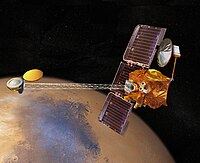
In 2001 NASA launched the successful Mars Odyssey orbiter, which is still in orbit as of August 2006. Odyssey's Gamma Ray Spectrometer detected significant amounts of elemental hydrogen in the upper meter or so of Mars' regolith. This hydrogen is thought to be contained in large deposits of water ice.[34]
In 2003, the ESA launched the Mars Express craft consisting of the Mars Express Orbiter and the lander Beagle 2. Beagle 2 apparently failed during descent and was declared lost in early February 2004.[35] In early 2004 the Planetary Fourier Spectrometer team announced it had detected methane in the Martian atmosphere. ESA announced in June 2006 the discovery of aurorae on Mars.[36]
Also in 2003, NASA launched the twin Mars Exploration Rovers named Spirit (MER-A) and Opportunity (MER-B). Both missions landed successfully in January 2004 and have met or exceeded all their targets. Among the most significant science returns has been the conclusive evidence that liquid water existed at some time in the past at both landing sites. Martian dust devils and windstorms have occasionally cleaned both rovers' solar panels, and thus increased their lifespan.[37]
On August 12 2005 the NASA Mars Reconnaissance Orbiter probe was launched toward the planet, to conduct a two-year science survey. The purpose of the mission is to map the Martian terrain and find suitable landing sites for the upcoming lander missions. It arrived in orbit on March 10, 2006. The next scheduled mission to Mars is the NASA Phoenix Mars lander, expected to launch in 2007.[38]
Future plans
Future plans for unmanned Mars Exploration include the sending of the Phoenix Lander in 2007, followed by the Mars Science Laboratory in 2009, the Phobos-Grunt sample-return mission, to return samples of Phobos, a Martian moon. Other missions have been proposed, although not yet confirmed.
Manned Mars exploration by the United States has been explicitly identified as a long-term goal in the Vision for Space Exploration announced in 2004 by US President George W. Bush.[39]
The European Space Agency hopes to land the first humans on Mars between 2030 and 2035. This will be preceded by successively larger probes, starting with the launch of the ExoMars probe in 2011 or more likely 2013,[40] followed by the 'Mars Sample Return Mission'. Likewise, astronauts will be sent to the moon between 2020 and 2025 in preparation for this mission.
Astronomical observations from Mars

- See also: Timekeeping on Mars
It is now possible, with the existence of various orbiters, landers, and rovers to study astronomy from the Martian skies. In particular, the Earth and the Moon would easily be visible to the naked eye. Also, one could observe the two moons of Mars. The moon Phobos appears about one third the angular diameter that the full Moon appears from Earth, and when it is full it is bright enough to cast shadows. On the other hand Deimos appears more or less starlike, and appears only slightly brighter than Venus does from Earth.[41]
There are also various phenomena well-known on Earth that have now been observed on Mars, such as meteors and auroras. The first meteor photographed on Mars was on March 7 2004 by the Spirit rover. Auroras occur on Mars, but they do not occur at the poles as on Earth, because Mars has no planetwide magnetic field. Rather, they occur near magnetic anomalies in Mars's crust, which are remnants from earlier days when Mars did have a magnetic field. They would probably be invisible to the naked eye, being largely ultraviolet phenomena.[42]
A transit of the Earth as seen from Mars will occur on November 10, 2084. At that time, the Sun, Earth and Mars will be exactly collinear. There are also transits of Mercury and transits of Venus, and the moon Deimos is of sufficiently small angular diameter that its partial "eclipses" of the Sun are best considered transits (see Transit of Deimos from Mars).
The only occultation of Mars by Venus observed was that of October 3, 1590, seen by M. Möstlin at Heidelberg.[43]
Viewing Mars
- See also: Aspects of Mars
To a naked-eye observer, Mars usually shows a distinct yellow, orange or reddish color, and varies in brightness more than any other planet, as seen from Earth, over the course of its orbit. When farthest away from the Earth, it is more than seven times as far from the latter as when it is closest (when least favourably positioned, it can be lost in the Sun's glare for months at a time). At its most favourable times — which occur twice every 32 years, alternately at 15 and 17-year intervals, and always between late July and late September — Mars shows a wealth of surface detail to a telescope. Especially noticeable, even at low magnification, are the polar ice caps.[44]
Approximately every 780 days opposition occurs, which is when Mars is nearest to Earth. This minimum distance varies between about 55 and 100 million km due to the planets' elliptical orbits.[45] The next Mars opposition will occur on December 24, 2007.
On August 27, 2003, at 9:51:13 UT, Mars made its closest approach to Earth in nearly 60,000 years: 55,758,006 km (approximately 35 million miles) without Light-time correction. This occurred when Mars was one day from opposition and about three days from its perihelion, making Mars particularly easy to see from Earth. The last time it came so close is estimated to have been on September 12, 57,617 BC. Detailed analysis of the solar system's gravitational landscape forecasts an even closer approach in 2287. However, this record approach was only very slightly closer than other recent close approaches. For instance, the minimum distance on August 22 1924 was 0.37284 AU, compared to 0.37271 AU on August 27 2003, and the minimum distance on August 24 2208 will be 0.37278 AU.[46]
Historical Observations of Mars
The history of observations of Mars are marked by the oppositions of Mars, when the planet is closest to Earth and hence is most easily visible, which occur every couple of years. Even more notable are the perihelic oppositions of Mars which occur approximately every 16 years, and are distiguished because Mars is close to perihelion making it even closer to Earth.
In September 1877, (a perihelic opposion of Mars occurred on September 5), Italian astronomer Giovanni Schiaparelli published the first detailed map of Mars. These maps notably contained features he called canali, that were later shown to be an optical illusion. These canali were supposedly long straight lines on the surface of Mars to which he gave names of famous rivers on Earth. His term was popularly mistraslated as canals, and so started the Martian canal controversy.
Following these observations, it was a long held belief that Mars contained vast seas and vegetation. It was not until spacecraft visited the planet during NASA's Mariner missions in the 1960s that these myths were dispelled. Some maps of Mars were made using the data from these missions, but it wasn't until the Mars Global Surveyor mission, launched in 1996 and still operational as of 2006, that complete, extremely detailed maps were obtained. These maps are now available online at Google Mars.
Mars in human culture
Historic connections
Mars is named after the Roman god of war. In Babylonian astronomy, the planet was named after Nergal, their deity of fire, war, and destruction, most likely due to the planet's reddish appearance.[47] When the Greeks equated Nergal with their god of war, Ares, they named the planet Ἄρεως ἀστἡρ (Areos aster), or "star of Ares". Then, following the identification of Ares and Mars, it was translated into Latin as stella Martis, or "star of Mars", or simply Mars. The Greeks also called the planet Πυρόεις Pyroeis meaning "fiery". In Hindu mythology, Mars is known as Mangala (मंगल). The planet is also called Angaraka in Sanskrit. He is the god of war and is celibate. He is the owner of the Aries and Scorpio signs, and a teacher of the occult sciences. The planet was known by the Egyptians as "Ḥr Dšr";;;; or "Horus the Red". The Hebrews named it Ma'adim (מאדים) - "the one who blushes"; this is where one of the largest canyons on Mars, the Ma'adim Vallis, gets its name. It is known as al-Mirrikh in both Arabic and Persian, and Merih in Turkish. The etymology of al-Mirrikh is unknown. Ancient Persians named it Bahram, the Zoroastrian god of faith. Ancient Turks called it Sakit. The Chinese, Japanese, Korean and Vietnamese cultures refer to the planet as 火星, or the fire star, a naming based on the ancient Chinese mythological cycle of Five Elements.
Its symbol, derived from the astrological symbol of Mars, a circle with a small arrow pointing out from behind it is a stylized representation of a shield and spear used by the Roman God Mars. Mars in Roman mythology was the God of War and patron of warriors. This symbol is also used in biology to describe the male sex.[48]
In fiction
The depiction of Mars in fiction has been stimulated by its dramatic red color and by early scientific speculations that its surface conditions might be capable of supporting life.
Until the arrival of planetary probes, the traditional view of Mars derived from the astronomers Percival Lowell and Giovanni Schiaparelli, whose observation of supposedly linear features on the planet created the myth of canals on Mars. For many years, the standard notion of the planet was a drying, cooling, dying world with ancient civilizations constructing irrigation works. Thus originated a large number of science fiction scenarios, the best known of which is H. G. Wells' The War of the Worlds, in which Martians seek to escape their dying planet by invading Earth. Of considerable note is the release of a radio broadcast of War of the Worlds on October 30, 1938. It was broadcasted as a news release, and many people mistook it for the truth. Also influential was Ray Bradbury's The Martian Chronicles, in which human explorers find a dying Martian civilization.
After the Mariner and Viking spacecraft had returned pictures of Mars as it really is, an apparently lifeless and canal-less world, these ideas about Mars had to be abandoned and a vogue for accurate, realist depictions of human colonies on Mars developed, the best known of which may be Kim Stanley Robinson's Mars trilogy. However, pseudo-scientific speculations about the Face on Mars and other enigmatic landmarks spotted by space probes have meant that ancient civilizations continue to be a popular theme in science fiction, especially in film.
Another popular theme, particularly among American writers, is the Martian colony that fights for independence from Earth. This is a major plot element in the novels of Greg Bear and Kim Stanley Robinson, as well as the movie Total Recall (based on a short story by Philip K. Dick) and the television series Babylon 5. Many video games also use this element, such as Red Faction and the Zone of the Enders series. Mars (and its moons) were also the setting for the popular Doom video game franchise and the later Martian Gothic .
See also
- Astrobiology
- Darian calendar
- Face on Mars photo article
- Flag of Mars
- List of artificial objects on Mars
- Extraterrestrial life
- Colonization of Mars
- Terraforming of Mars
- Mars Direct
- Mars in astrology
References
- ↑ Peplow, Mark, "How Mars got its rust" - 6 May 2004 article from Nature.com. URL accessed 18 April 2006.
- ↑ 2.0 2.1 David R. Williams (2004-09-01). Mars Fact Sheet. National Space Science Data Center. NASA. Retrieved on 2006-06-24.
- ↑ NASA Mars Page. Volcanology of Mars. Retrieved on June 13, 2006.
- ↑ NASA (2004-03-18). Mineral in Mars 'Berries' Adds to Water Story. Press release. Retrieved on 2006-06-13.
- ↑ "New Map Provides More Evidence Mars Once Like Earth" - Oct. 12, 2005 Goddard Space Flight Center Press release. URL accessed March 17, 2006.
- ↑ Dave Jacqué. APS X-rays reveal secrets of Mars' core, Argonne National Laboratory, 2003-09-26. Retrieved on 2006-07-01. (in English)
- ↑ Areographers. The Planet Mars: A History of Observation and Discovery. Retrieved on 2006-06-13.
- ↑ Olympus Mons (Nix Olympica). Iomoon.com. Retrieved on 2006-06-13.
- ↑ Airy-0. Absolute Astronomy. Retrieved on 2006-06-13.
- ↑ Topography. Physical Mars. Retrieved on June 13, 2006.
- ↑ Syrtis Major. Encyclopedia of Astrobiology, Astronomy & Spaceflight. Retrieved on June 13, 2006.
- ↑ Mars Global Geography. Windows to the Universe. Retrieved on June 13, 2006.
- ↑ Lemmon et al., "Atmospheric Imaging Results from the Mars Exploration Rovers: Spirit and Opportunity"
- ↑ "Mars Express confirms methane in the Martian atmosphere" - March 30, 2004 ESA Press release. URL accessed March 17, 2006.
- ↑ Martin Baucom (2006). "Life on Mars?". American Scientist 94 (2).
- ↑ C. Oze, M. Sharma (2005). "Have olivine, will gas: Serpentinization and the abiogenic production of methane on Mars". Geophys. Res. Lett. 32: L10203. DOI:10.1029/2005GL022691. Research Blogging. URL accessed 18 April 2006.
- ↑ J. T. Mellon, W. C. Feldman, T. H. Prettyman (2003). "The presence and stability of ground ice in the southern hemisphere of Mars". Icarus 169 (2): 324-340.
- ↑ "Mars Rovers Spot Water-Clue Mineral, Frost, Clouds" - Dec. 13, 2004 NASA Press release. URL accessed March 17, 2006.
- ↑ "The Solar Wind at Mars" - Jan. 31, 2001 Science@NASA article. URL accessed September 8, 2006.
- ↑ [1]
- ↑ SEASONS AND CLIMATE ON MARS. Starry Skies. Retrieved on June 7, 2006.
- ↑ Orbiter's Long Life Helps Scientists Track Changes on Mars - Sept. 20, 2005 NASA Press release. URL accessed March 17, 2006.
- ↑ Planet Gobbling Dust Storms. Science @ NASA. Retrieved on June 7, 2006.
- ↑ Close Inspection for Phobos. ESA website.
- ↑ ARES ATTENDANTS: DEIMOS & PHOBOS. Greek Mythology.
- ↑ Phobos. nineplanets.
- ↑ Phobos. nineplanets.
- ↑ Vladimir A. Krasnopolsky, Jean-Pierre Maillard, Tobias C. Owen (2004). "Detection of methane in the Martian atmosphere: evidence for life?". Icarus 172: 537-547. DOI:10.1016/j.icarus.2004.07.004. Research Blogging.
- ↑ "Formaldehyde claim inflames martian debate" - February 25, 2005, http://www.nature.com news story. URL accessed March 19, 2006.
- ↑ Christopher Oze and Mukul Sharma (2005). "Have olivine, will gas: Serpentinization and the abiogenic production of methane on Mars". Geophysical Research Letters 32: L10203.
- ↑ Is the Great Galactic Ghoul losing his appetite?. The space review. Retrieved on June 13, 2006.
- ↑ Other Mars Missions. Journey through the galaxy. Retrieved on June 13, 2006.
- ↑ Mars Global Surveyor. CNN- Destination Mars. Retrieved on June 13, 2006.
- ↑ Odyssey Spacecraft Generates New Mars Mysteries. Space.com. Retrieved on June 13, 2006.
- ↑ Europe's Beagle 2 Mars Probe Stays Ominously Silent. Space.com. Retrieved on June 13, 2006.
- ↑ http://www.esa.int/SPECIALS/Mars_Express/SEMLQ71DU8E_0.html
- ↑ Mars Exploration Rovers- Science. NASA MER website. Retrieved on June 13, 2006.
- ↑ MRO: Science. NASA's MRO website. Retrieved on June 13, 2006.
- ↑ When do we get to Mars?. Space.com FAQ: Bush's New Space Vision. Retrieved on June 13, 2006.
- ↑ ExoMars. Homepage of Aurora project at ESA. Retrieved on June 20, 2006.
- ↑ Deimos. Planetary Societies's Explore the Cosmos. Retrieved on June 13, 2006.
- ↑ Discovery of an aurora on Mars. Nature Magazine. Retrieved on June 13, 2006.
- ↑ Stephen Breyer (March 1979). "Mutual Occultation of Planets". Sky and Telescope 57 #3: 220.
- ↑ Mars. Shallow Sky.
- ↑ Mars Fact Sheet. NASA planetary factsheets.
- ↑ NightSky Friday - Mars and Earth: The Top 10 Close Passes Since 3000 B.C.. Space.com.
- ↑ Motions of Mars. The Planet Mars: A History of Observation and Discovery. Retrieved on June 13, 2006.
- ↑ Planet Symbols. NASA solar system exploration. Retrieved on June 13, 2006.
External links
Template:Sisterlinks Template:Portal
- The Planet Mars: A History of Observation and Discovery,William Sheehan, The University of Arizona Press, Tucson, 1996
- Detection of methane in the Martian atmosphere: evidence for life?,Vladimir A. Krasnopolsky, Jean-Pierre Maillard, Tobias C. Owen, Icarus, 172 (2), 537-547.
- NASA's Mars fact sheet
- 3D maps of Mars in NASA World Wind
- Google Mars Interactive image of Mars
- Flight Into Mariner Valley NASA/JPL/Arizona State University 3D flythrough of Valles Marineris
- Marsgeo.com Mars Rover photos, videos & surface geology
- Nine Planets Mars page
- Introduction to Martian topography, with Hubble Space Telescope photos
- FU Berlin: HRSC (camera) experiment at Mars Express (eng. & ger.; press releases and high resolution images)
- Technical Notes about Time on Mars
- On Mars: Exploration of the Red Planet 1958-1978 from the NASA History Office.
- A Trip Into Space Photos and descriptions of Mars
- Martian Law - a CATO white paper
- Computer Simulation of a flyby through Mariner Valley
- Mars Unearthed - Comparisons of terrains between Earth and Mars
- 3D VRML Mars globe
- Ralph Aeschliman's Online Atlas of Mars
- Planets - Mars A kid's guide to Mars.
- Is there Global Warming on Mars?
- BBC: Wheels on Mars
- Space.com: All About Mars
- Geody Mars World's search engine that supports NASA World Wind, Celestia, and other applications.
Water
- Highly visible ice lake found on Mars - BBC
- Dr. Tony Phillips: "Making a Splash on Mars", Science@NASA article, June 29, 2000. Phillips describes the Martian "gullies" and explains the conditions under which liquid water can exist on the surface of Mars.
- BBC News story on subsurface ice deposits on Mars
- BBC News update on Mars Express' findings of polar water ice and water-eroded features on the surface
- Mars Rover Scientists Wring Water Story from Rocks This image taken by Mars Rover Opportunity shows microscopic rock forms indicating past signs of water. Courtesy: NASA
- BBC News Mars pictures reveal frozen sea
Exploration
- The Political Economy of Very Large Space Projects (Journal Of Evolution and Technology)
- exploreMarsnow Interactive Mars base simulation. Winner of 2003 Webby Award for Science.
- NASA Mars Exploration Rover Home Page
- Be on Mars Anaglyphs from the Mars Rovers (3D)
- Martian Travel Guide Student's project for Catch a Star
Template:Mars Footer Template:Footer SolarSystem
Template:Link FA Template:Link FA Template:Link FA Template:Link FA Template:Link FA Template:Link FA Template:Link FA
als:Mars (Planet) ar:مريخ ast:Marte (planeta) bn:মঙ্গলগ্রহ zh-min-nan:Hoé-chheⁿ bs:Mars br:Meurzh (planedenn) bg:Марс (планета) ca:Mart (planeta) cs:Mars (planeta) co:Marte cy:Mawrth (planed) da:Mars (planet) de:Mars (Planet) et:Marss el:Άρης (πλανήτης) es:Marte (planeta) eo:Marso eu:Martitz (planeta) fa:بهرام (سیاره) fr:Mars (planète) ga:Mars (pláinéad) gl:Marte (planeta) ko:화성 hi:मार्स hr:Mars (planet) io:Marso ilo:Mars (planeta) id:Mars ia:Marte os:Марс (планетæ) is:Mars (reikistjarna) it:Marte (astronomia) he:מאדים kn:ಮಂಗಳ ka:მარსი (პლანეტა) kw:Meurth (planet) sw:Meriki ku:Behram (gerstêrk) la:Mars (planeta) lv:Marss (planēta) lb:Mars (Planéit) lt:Marsas (planeta) li:Mars (planeet) hu:Mars (bolygó) mt:Marte (pjaneta) ms:Marikh nl:Mars (planeet) ja:火星 no:Mars (planet) nn:Planeten Mars ug:مارس (ئاسترونومىيە) pam:Mars nds:Mars pl:Mars pt:Marte ro:Marte (planetă) ru:Марс sco:Maurs sq:Marsi scn:Marti simple:Mars (planet) sk:Mars sl:Mars (planet) sr:Марс fi:Mars sv:Mars (planet) tl:Marte ta:செவ்வாய் (கோள்) th:ดาวอังคาร vi:Sao Hỏa tr:Mars (gezegen) uk:Марс (планета) wa:Måss (planete) zh-yue:火星 zh:火星

